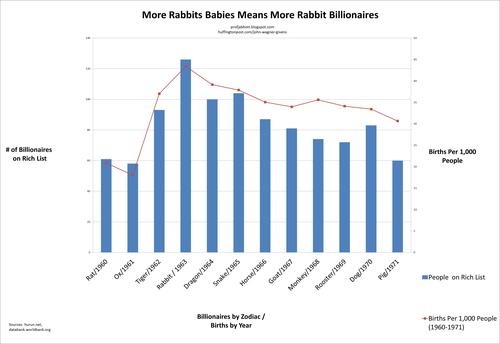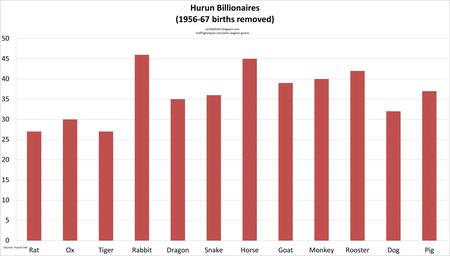
On September 24th, Hurun, the premier magazine about and for China's uber-wealthy, published its annual "rich list" of the 1,000 wealthiest people born and bred in mainland China. Zong Qinghou regained the top spot by ratcheting his family's net worth up to $12.6 billion. Zong is chairman of the Wahaha group, a beverage conglomerate whose ubiquitous bottled water has hydrated this blogger from Hainan to Harbin. The Economist, in a rare display of unthoughtful silliness (they normally excel at the thoughtful kind), jumped to the heart of the issue by producing a graph showing that the list included a disproportionate number of rabbits under the Chinese zodiac. Even if one takes the zodiac seriously, this would be surprising as rabbits would generally be thought to lag far behind rats, and perhaps other signs, at accumulating wealth.
A disproportionate number of rabbits do seem to appear on the list, indeed the number was a smidge over two standard deviations above the mean. As a social scientist, however, I was suspicious. The zodiac can have real effects; for example, many Chinese prefer to have dragon children and, hence, significantly more Chinese children tend to be born the year of the dragon. I was doubtful, however, that this was what was going on here.
As seen in the first graph, a quick look at Chinese birthrates provides a demographic explanation for the disproportionate number of rabbits: an explosion of births in the rabbit year 1963. This peak, however, has little to do with the Chinese zodiac. In 1963, China was just getting over the devastation of the Great Leap Forward, a social and economic campaign that was designed to turbo-charge China's development, but generally resulted in famine, devastation and low birth rates. In 1966, births dropped again as the country descended into the chaos of the Cultural Revolution. Finally, the introduction of the One Child Policy in 1978 ensured that birth rates stayed low.
More children were born in 1963, which means there are more rabbit billionaires. The effect is especially pronounced because 1963 falls right in the middle of the cohort of billionaires, whose average birth year was 1960. The impact of these shifting demographics can be seen fairly clearly in the second graph.
In other words, there are not a surprising number of rabbit billionaires, but a disproportionate number of rabbits amongst Chinese people age 40-60, the prime age for billionaires in China. As seen in the third graph, if you control for these demographics, by, for example, removing the 12 year cycle from 1956-67, suddenly the rabbit advantage dematerializes and all the numbers fall easily within two standard deviations.
In a clear example of what the Chinese might call "using a cannon to kill a mosquito (大炮打蚊子)," I ran a simple regression to see if the rabbits on the list were richer than other zodiacs. After all, if being a rabbit really helped you to get onto the list in the first place, then surely we would also expect rabbits to be disproportionately wealthy even among their peers. The results, however, showed that being a rabbit had no statistically significant effect.
It should be pointed out that all of these techniques are less accurate because the Chinese year does not line up perfectly with the Western one, so that a billionaire born in 1963 but before January 25, for example, is technically a tiger not a rabbit. Still, if the effect was truly pronounced, we would only expect this difficulty to mute the impact, not make it imperceptible.
The Hurun list, then, provides little fodder for those interested in, say, playing the stock market based on the Chinese zodiac of CEOs. In a future post, however, I will show what the list and my regression do tell us about how best to make a fortune in China and about women's chances of making it onto the list.



